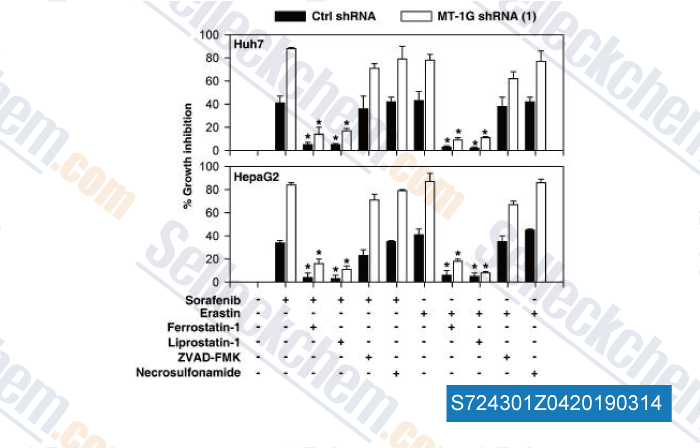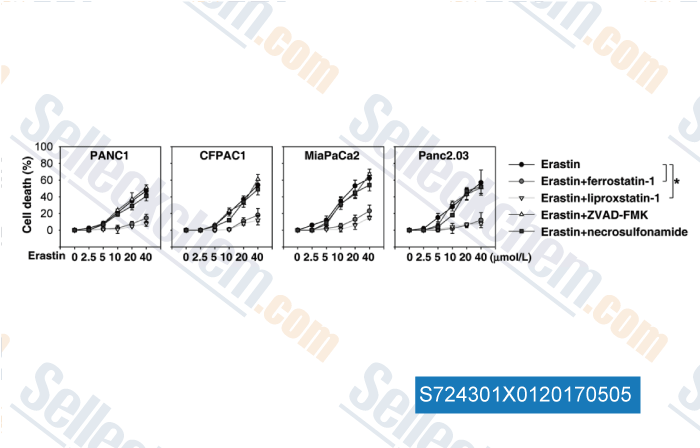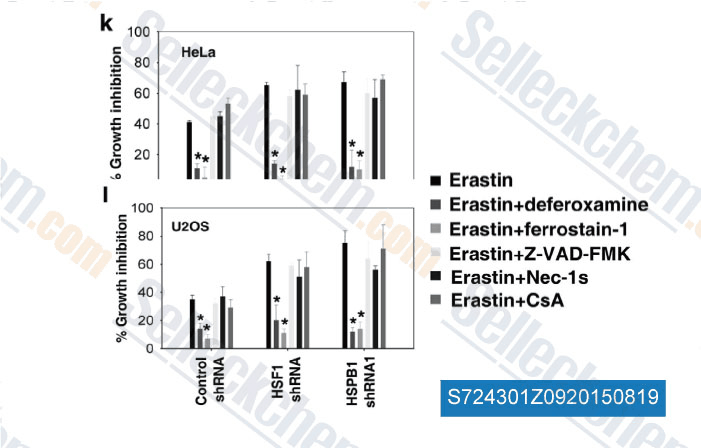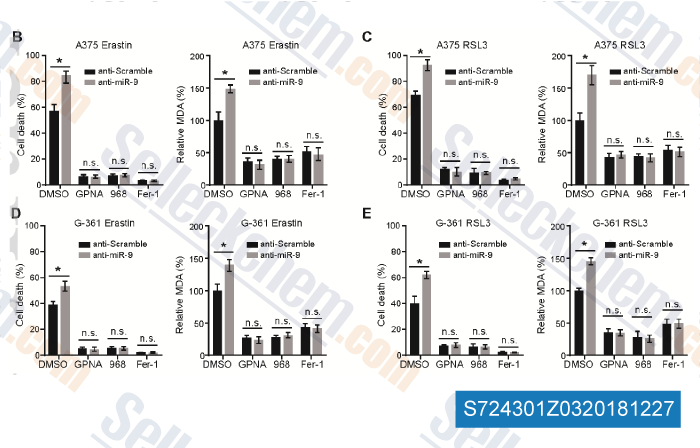|
Toll Free: (877) 796-6397 -- USA and Canada only -- |
Fax: +1-832-582-8590 Orders: +1-832-582-8158 |
Tech Support: +1-832-582-8158 Ext:3 Please provide your Order Number in the email. |
Technical Data
| Formula | C15H22N2O2 |
||||||
| Molecular Weight | 262.35 | CAS No. | 347174-05-4 | ||||
| Solubility (25°C)* | In vitro | DMSO | 55 mg/mL (209.64 mM) | ||||
| Ethanol | 55 mg/mL (209.64 mM) | ||||||
| Water | Insoluble | ||||||
| In vivo (Add solvents to the product individually and in order) |
|
||||||
|
* <1 mg/ml means slightly soluble or insoluble. * Please note that Selleck tests the solubility of all compounds in-house, and the actual solubility may differ slightly from published values. This is normal and is due to slight batch-to-batch variations. * Room temperature shipping (Stability testing shows this product can be shipped without any cooling measures.) |
|||||||
Preparing Stock Solutions
Biological Activity
| Description | Fer-1 (Ferrostatin-1) is a potent and selective inhibitor of ferroptosis with EC50 of 60 nM. | ||
|---|---|---|---|
| Targets |
|
||
| In vitro | Ferrostatin-1 (2 μM) prevents erastin-induced ferroptosis in cancer cells, as well as glutamate-induced cell death in postnatal rat brain slices. Ferrostatin-1 is a lipid ROS scavenger, with the N-cyclohexyl moiety serving as a lipo-philic anchor within biological membranes. Ferrostatin-1 does not inhibit extracellular signal -regulated kinase (ERK) phos-phorylation or arrest the proliferation of HT-1080 cells, suggesting that it does not inhibit the MEK/ERK pathway, chelate iron, or inhibit protein synthesis. Ferrostatin-1 does, however, prevent erastin-induced accumulation of cytosolic and lipid ROS. Ferrostatin-1 readily oxidizes the stable radical 2,2-diphenyl-1-picrylhydrazyl (DPPH) under cell-free conditions. [1] |
||
| In vivo | Ferrostatin-1 (Fer-1), a synthetic antioxidant, is a potent and selective inhibitor of ferroptosis. It acts via a reductive mechanism to prevent damage to membrane lipids and thereby inhibits cell death.[2] |
Protocol (from reference)
| Cell Assay: |
|
|---|---|
| Animal Study: |
|
References
|
Customer Product Validation

-
Data from [Data independently produced by , , Hepatology, 2016, 64(2):488-500]

-
Data from [Data independently produced by , , Cancer Res, 2017, 77(8):2064-2077]

-
Data from [Data independently produced by , , Oncogene, 2015, 10.1038/onc.2015.32]

-
Data from [Data independently produced by , , Mol Carcinog, 2018, 57(11):1566-1576]
Selleck's Fer-1 (Ferrostatin-1) has been cited by 585 publications
| S100P is a ferroptosis suppressor to facilitate hepatocellular carcinoma development by rewiring lipid metabolism [ Nat Commun, 2025, 16(1):509] | PubMed: 39779666 |
| Targeting pancreatic cancer glutamine dependency confers vulnerability to GPX4-dependent ferroptosis [ Cell Rep Med, 2025, 6(2):101928] | PubMed: 39879992 |
| A novel FTO-targeting nanodrug induces disulfidptosis and ameliorates the suppressive tumor immune environment to treat uveal melanoma [ Biomaterials, 2025, 319:123168] | PubMed: 40015005 |
| Ironomycin induces mantle cell lymphoma cell death by targeting iron metabolism addiction [ Theranostics, 2025, 15(7):2834-2851] | PubMed: 40083931 |
| SLC25A1 and ACLY maintain cytosolic acetyl-CoA and regulate ferroptosis susceptibility via FSP1 acetylation [ EMBO J, 2025, 10.1038/s44318-025-00369-5] | PubMed: 39881208 |
| ROR1 CAR-T cells and ferroptosis inducers orchestrate tumor ferroptosis via PC-PUFA2 [ Biomark Res, 2025, 13(1):17] | PubMed: 39849645 |
| CHMP4C promotes pancreatic cancer progression by inhibiting necroptosis via the RIPK1/RIPK3/MLKL pathway [ J Adv Res, 2025, S2090-1232(25)00058-X] | PubMed: 39870301 |
| LncRNA CRCMSL interferes in phospholipid unsaturation to suppress colorectal cancer progression via reducing membrane fluidity [ J Adv Res, 2025, S2090-1232(25)00075-X] | PubMed: 39921055 |
| HAT1/HDAC2 mediated ACSL4 acetylation confers radiosensitivity by inducing ferroptosis in nasopharyngeal carcinoma [ Cell Death Dis, 2025, 16(1):160] | PubMed: 40050614 |
| Inhibition of KLF5 promotes ferroptosis via the ZEB1/HMOX1 axis to enhance sensitivity to oxaliplatin in cancer cells [ Cell Death Dis, 2025, 16(1):28] | PubMed: 39827156 |
RETURN POLICY
Selleck Chemical’s Unconditional Return Policy ensures a smooth online shopping experience for our customers. If you are in any way unsatisfied with your purchase, you may return any item(s) within 7 days of receiving it. In the event of product quality issues, either protocol related or product related problems, you may return any item(s) within 365 days from the original purchase date. Please follow the instructions below when returning products.
SHIPPING AND STORAGE
Selleck products are transported at room temperature. If you receive the product at room temperature, please rest assured, the Selleck Quality Inspection Department has conducted experiments to verify that the normal temperature placement of one month will not affect the biological activity of powder products. After collecting, please store the product according to the requirements described in the datasheet. Most Selleck products are stable under the recommended conditions.
NOT FOR HUMAN, VETERINARY DIAGNOSTIC OR THERAPEUTIC USE.
